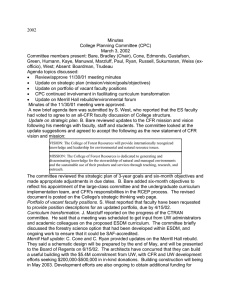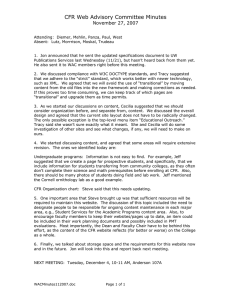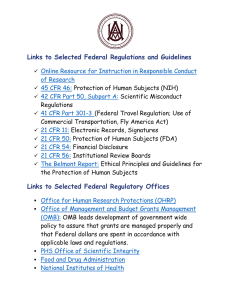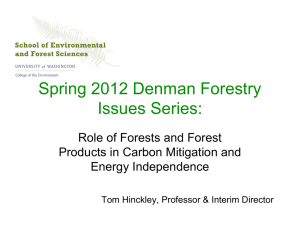Document 13449488
advertisement
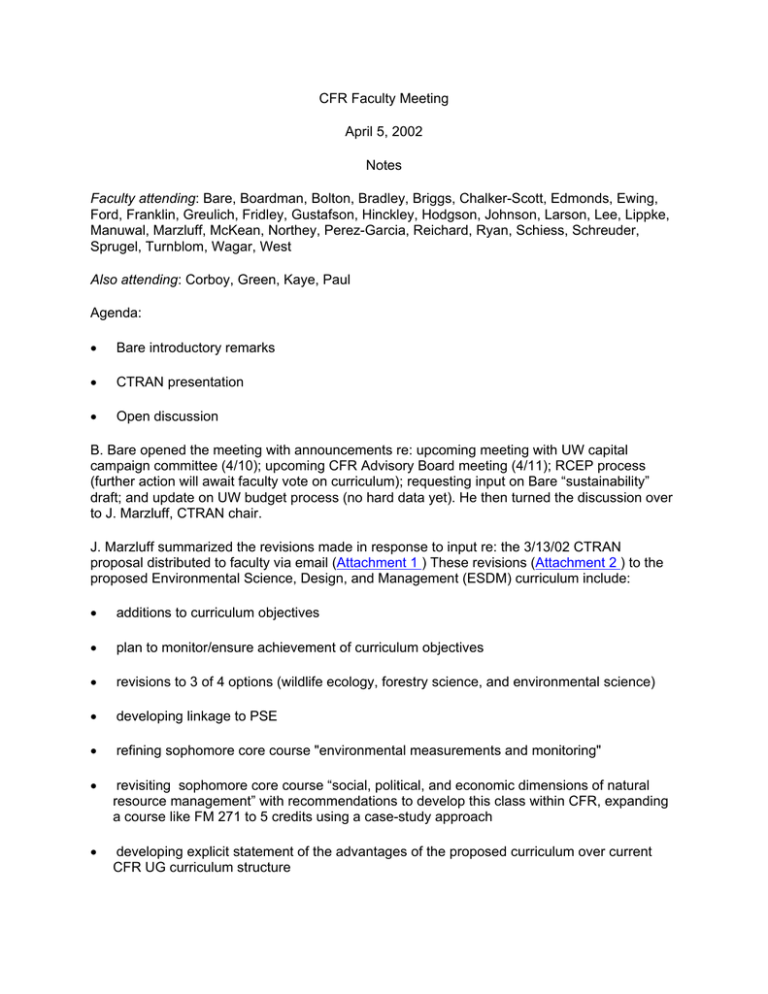
CFR Faculty Meeting April 5, 2002 Notes Faculty attending: Bare, Boardman, Bolton, Bradley, Briggs, Chalker-Scott, Edmonds, Ewing, Ford, Franklin, Greulich, Fridley, Gustafson, Hinckley, Hodgson, Johnson, Larson, Lee, Lippke, Manuwal, Marzluff, McKean, Northey, Perez-Garcia, Reichard, Ryan, Schiess, Schreuder, Sprugel, Turnblom, Wagar, West Also attending: Corboy, Green, Kaye, Paul Agenda: • Bare introductory remarks • CTRAN presentation • Open discussion B. Bare opened the meeting with announcements re: upcoming meeting with UW capital campaign committee (4/10); upcoming CFR Advisory Board meeting (4/11); RCEP process (further action will await faculty vote on curriculum); requesting input on Bare “sustainability” draft; and update on UW budget process (no hard data yet). He then turned the discussion over to J. Marzluff, CTRAN chair. J. Marzluff summarized the revisions made in response to input re: the 3/13/02 CTRAN proposal distributed to faculty via email (Attachment 1 ) These revisions (Attachment 2 ) to the proposed Environmental Science, Design, and Management (ESDM) curriculum include: • additions to curriculum objectives • plan to monitor/ensure achievement of curriculum objectives • revisions to 3 of 4 options (wildlife ecology, forestry science, and environmental science) • developing linkage to PSE • refining sophomore core course "environmental measurements and monitoring" • revisiting sophomore core course “social, political, and economic dimensions of natural resource management” with recommendations to develop this class within CFR, expanding a course like FM 271 to 5 credits using a case-study approach • developing explicit statement of the advantages of the proposed curriculum over current CFR UG curriculum structure R. Lee distributed an alternative proposal by a faculty group to develop a three-pronged curricular model that included: a general curriculum in environmental science and issues; a package of related professional programs focused on environmental management and design; and paper science and engineering. The distributed proposal dealt most specifically with the professional management and design prong (Professional Environmental Management and Design (EMD). In the proposal, EMD would consist of two curricula – the current EHUF and a new Sustainable Forest Operations (SFO) curriculum that would share a common core of identical or similar courses (including a common professional core). Each of the two curricula would be divided into three separate tracks (EHUF: environmental horticulture, public horticulture, and urban forestry; SFO: forest operations, sustainable forestry, and forest engineering). The two alternative proposals (ESDM and EMD) were discussed at some length. Questions and comments in support of the EMD proposal included: • EMD provides a way to maintain the visibility and distinct identities of some CFR professional programs. • EMD provides greater opportunity for disciplinary grounding. • Some employers may be more comfortable with the distinct identities and increased disciplinary depth of the EMD curricula. • Having three distinct pathways (environmental science, professional management and design, and paper science and engineering) may be an appropriate way to solve dilemma of under-enrolled or declining CFR programs. • Integration is achieved around core requirements in communication, science, analysis, and professional aspects. However the common core is achieved not through specific courses but through common knowledge sets. In some cases other UW units might more appropriately deliver these common knowledge sets. • There was a suggestion that the number of proposed options within the two EMD curricula (three each) is too cumbersome and that it might be better to start off with just one main option each (i.e., environmental horticulture and urban forestry; and sustainable forest operations). • The alternative proposal’s three-prong approach better accommodates the diversity within CFR. The goal shouldn’t be to have a common core just for the sake of having it. Other UW professional units with diverse subject matters (e.g. CAUP) do not have a common core for all of UG programs. Questions and comments in support of the ESDM proposal included: • ESDM proposal lays out a model that is efficiently integrated at the sophomore and senior levels with minimal requirements, leaving ample opportunity in the junior year and through restricted electives to maintain disciplinary depth. • It was suggested that since the EMD proposal has a common core that appears similar to the ESDM core, one core should be able to apply to both alternatives. • Distinct program identities and visibility do not necessarily require separate curricula, but are more importantly a matter of packaging and marketing. • A common core curriculum for all CFR programs (with exception of PSE, although some argued that PSE should not be exempt) will create not only a community of students, but also a community of faculty who are able to work together toward common goals. Discussion ensued, with different points of view on how important, attainable, or desirable it is for all CFR students (including students in the current EHUF and PSE programs) to feel part of a common community. • It was suggested that continued “balkanization” is not in the best interest of CFR vis-à-vis UW strategic goals. • The integrated approach to environmental science, design, and management will have broad appeal to prospective students and to employers. Questions and comments relating generally to the two alternative proposals and to the curriculum transformation process included: • It may useful and desirable for the faculty to have at least two fully developed alternatives to evaluate and vote on. The models could be evaluated on a number of identified criteria, e.g., efficiency, integration, etc. • ESDM stresses integration first, disciplinary depth later, while EMD stresses getting depth before integrating. • There is no “optimal” number of curricula – just a sense that there shouldn’t be “too many”; how many is too many? • It was suggested that the discussion could usefully be separated into two distinct issues: (1) the adoption of a core curriculum required for all or most CFR UG programs and the tradeoffs involved; and (2) the question of how many and which options/majors/curricula should there be. Perhaps the key is the definition of the core and whom should it embrace? • Can or should current programs with low enrollments (e.g., FEE) reasonably be continued (as would be the case in the EMD alternative)? • Basic issue is how to attract more majors into CFR – it was generally agreed that an environmental science curriculum will be attractive and that there is a niche at UW now to be filled – if CFR doesn’t fill it soon some other unit/units will. • An unresolved question is whether separating the environmental science curriculum from “professional” curricula or whether an integrated environmental science, design, and management curriculum with various options, including professional options, will be more attractive to prospective students. How can CFR be sure what students want – in any event, whatever change is made there will be some risk. • Capstone courses in both models need further attention and development. • Attracting large numbers of new students into CFR will require increased faculty loads – how to deal with the large numbers of restricted or directed electives in both proposals that are current or proposed CFR courses? It was suggested that these lists need to be looked at for further possibilities of increased efficiency/integration. • Development of an environmental science degree, attractive to many new CFR majors, will be an extremely time consuming effort requiring much planning and work. • Implementation of any major change will require coordination so that the transition is efficient and is not damaging to current program majors. Suggested next steps (no definite agreement): • CTRAN and faculty group developing alternative proposal work together to develop one proposal? • Each group looks at the alternative proposal to see if and how a better integration might occur? The meeting adjourned at approximately 3:30 p.m.

